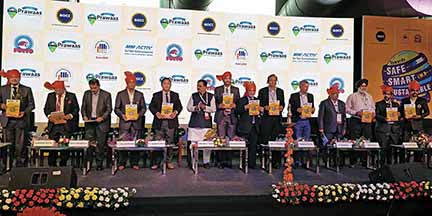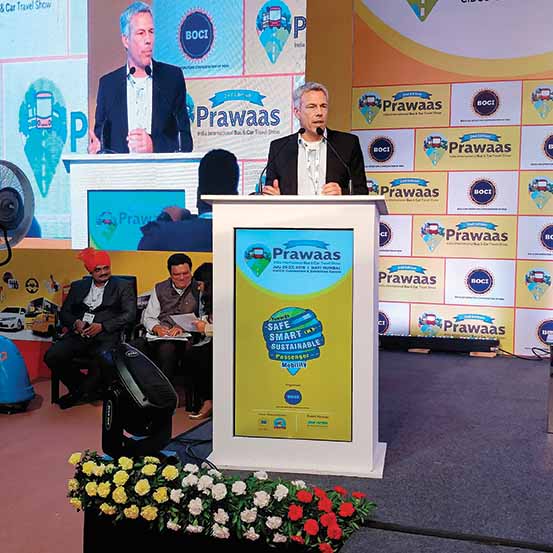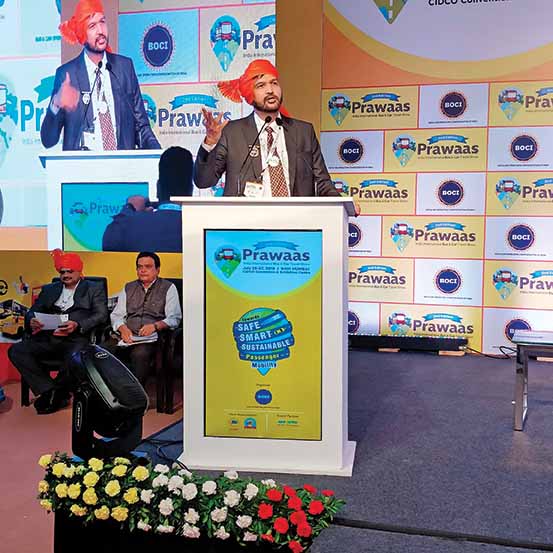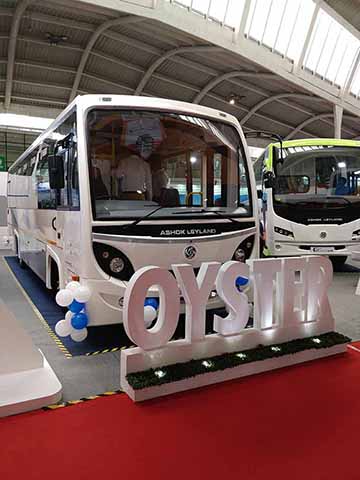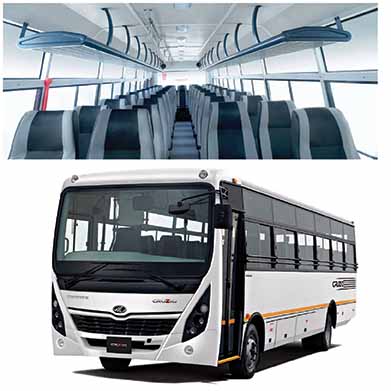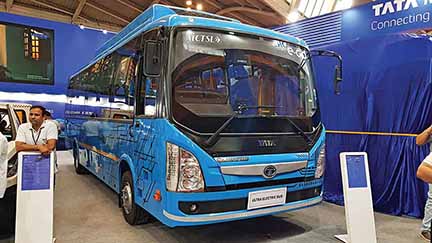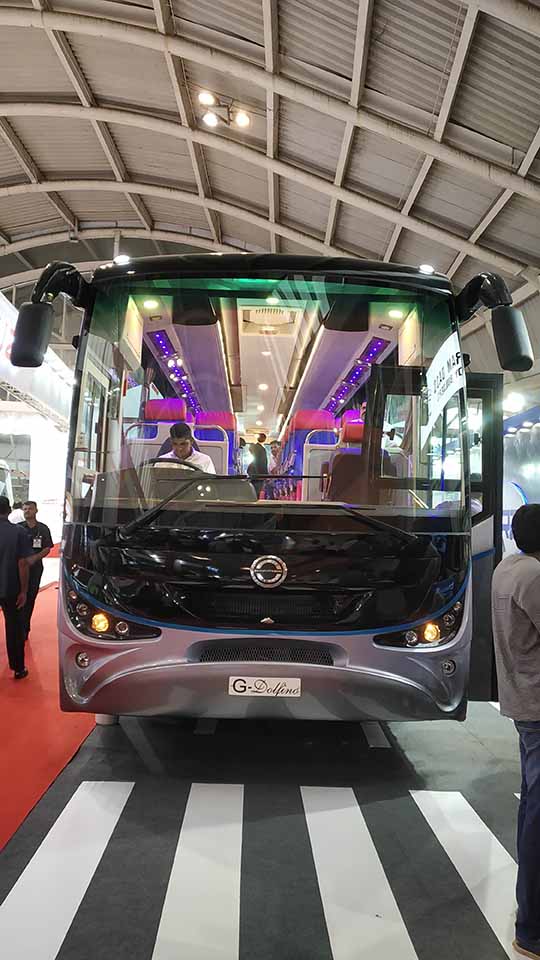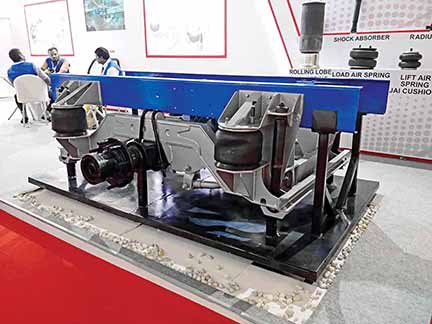The second edition of Prawaas, held in Mumbai, turned out to be a bigger success.
Story and Photos by:
Ashish Bhatia
The bigger and better second edition of Prawaas, a biennial event, was organised by the Bus and Car Operators Confederation of India (BOCI) along with host associations, Mumbai Bus Malak Sanghatana (MBMS) and Federation of Tourist Taxi Operators (FOTTO). Held over three-days, from July 25-27, 2019 at Navi Mumbai’s CIDCO Convention and Trade Centre, the event attracted stakeholders of the private bus and cab industry. The theme of this edition being, ‘Safe, Smart and Sustainable Passenger Mobility’, the show witnessed healthy participation of close to 10000 visitors, 150 exhibitors, 100 speakers and 5000 operators from 28 states and nine union territories. Spread over 150000 sq. ft., the booths across the three exhibition halls were abuzz with Original Equipment Manufacturers (OEMs), bus body builders, and components manufacturers. Attracting exhibitors of diverse nature, companies from IT and mobility, training and skill development, and finance and insurance, State Transport Undertakings (STUs) and tourism boards, the show, like the inaugural edition attracted private bus and cab operators from almost every nook an corner of the country. Drawing a large contingent of private bus operators from Assam for example, the show saw Government ministers from the centre and various state attend it. In his address, Nitin Gadkari, Minister for Road Transport, Highways and Ministry of Micro, Small and Medium Enterprises, Government of India, lauded BOCI for its efforts to bring mobility stakeholders from all over the country on one platform. “Online registration of vehicles, one nation one permit, amendment in Motor Vehicle Act to remove educational qualification criteria, subsidies for electric vehicles and provision of better infrastructure like bus-ports will revolutionise public transport,” he announced. The minister to facilitate simplification of processes, higher degree of transparency and a corruption-free system.
Explained Diwakar Raote, Minister for Transport, Government of Maharashtra, in his speech, “We have taken a number of initiatives that will ease the pain of commuters and make operations profitable for the operators.” Her drew attention to initiatives like the 40 per cent fare reduction of MSRTC’s Shivshahi bus service and a strategy to convert the 18,500 strong MSRTC bus fleet to LNG. Criticizing the present policy to subsidise electric buses to make the buses affordable, the minister called for greater cooperation among the stakeholders to ensure a win-win proposition for all. Prasanna Patwardhan, President, Bus Operators Confederation of India, expressed that they are elated to have all the key stakeholders for engagement and to explore solutions that would shape the ‘Transport of Tomorrow’. He drew attention to how the technology of buses in the country was changing at a pace slower than expected. Touching upon environmental concerns, and the potential for electric vehicles, Patwardhan opined, “EVs will play a huge role in mass mobility going forward.” He expressed of a need for policy and infrastructure to keep pace with the changing technology. Drawing attention to the country’s poor track record in road safety, KT Rajashekhara, Chairman, Bus Operators Confederation Of India, called upon the government to take adequate measures. “Accidents don’t take place accidentally,” he quipped. Making a strong case for the government to uplift private transporters and public transport, Rajashekara stressed upon stricter enforcement of rules to elevate safety.
Citing the recent move to rationalise bus fares in Maharashtra, Aaditya Thackery, President, Yuva Sena, Youth Wing of Shiv Sena, said that transport is one of the most critical aspects of development and no state can progress unless it has a robust transportation system in place.” “Maharashtra as a state has taken a number of key initiatives like rationalisation of bus fares, which has resulted in an exponential rise in commuters,” he averred. Thackery referred to the 50 per cent reduction in fares of Brihanmumbai Electric Supply and Transport (BEST) city bus operations in Mumbai in an effort to make it, profitable and sustainable once again. Stating that they were aware of the industry pain points, he spoke about preparing a 20-year industry roadmap. Touching upon the need to give shape to a multi-modal transport system for better last mile connectivity, governments move to throw open BEST depots across Mumbai for parking private buses.
Sharing of thoughts and knowledge
Held along side the exhibition, the session on ‘Stage Operations and its changing role’ saw Jalaj Gupta, Head Sales, Global Buses, Ashok Leyland, speak about the governments, OEs, operators and aggregators being the four important stakeholders in the transportation sector. “The government must play key roles in matters like the implementation of bus body code, and the uniform implementation of AIS 153,”he expressed. A session on ‘School Bus Challenges’, saw panellists speak about the opportunities in the segment, and how they cannot be realised because of the various challenges faced. Touching upon the safety features in school buses, they stressed on uniform implementation of features like the panic button, tracking system and cameras for end-to-end monitoring. Opining that the industry would have to bear higher compliance costs, the panelists found a common ground on enhancing safety and security of school children. As part of Yuva BOCI, startups attracted much attention for the ‘out of the box’ solutions on accessibility and inclusivity, sustainability and carbon footprint, e-mobility, and the role of IoT in transport. The session on ‘Public Private Partnership in Delivering Bus Transport’ highlighted the role of the government, OEMs and operators, and aggregators in shaping up an ecosystem for seamless passenger connectivity and mobility. Gerald Ollivier, Lead Transport Specialist, World Bank, stated, “Authorities need to create non-fare based revenues and subsidies to supplement the shortfall in fare based revenues.” He called for the need to reflect upon the positive impact of bus services on overall mobility and the need for clear planning, funding and performance monitoring responsibilities in addition to the need to have a mechanism in place for balanced contracting with private operators. Ollivier called for operations backed by secured funding and key performance indicators. This, he said, should be monitored through centralised systems.
In the session on ‘Shared mobility: A game-changer or trouble maker?’, emerging trends were focused upon in context to the rising congestion and pollution. The need to curtail taxation in a manner that makes commuting affordable was emphasised upon. On the ‘Role of Mobility in Tourism’, the reason for tourism to under-perform was blamed on the lack of adequate connectivity. The participants were unanimous in their call for the government and private operators to ensure safe and secure transport; to make it more viable for tourists to avail of better mobility alternatives.
Awards
The ‘BOCI Excellence Awards’ at Prawaas 2019 saw outperforming players being appreciated. Due recognition for extraordinary contribution by fleet operators across different fleet categories was extended. Company’s found to promote best practices, showcasing achievements and encouraging innovation, and those redefining the paradigms of passenger mobility were felicitated.
Ashok Leyland Ltd.
Ashok Leyland Ltd., launched the ‘Oyster’ next-generation midi-bus positioned at the premium end. Designed to offer comfortable travel for tourists and office goers alike, the bus draws from the success of the same platform in gulf markets. Expressed Anuj Kathuria, COO, Ashok Leyland, that the Oyster will be a game changer in public transport space. Relevant for city-dwellers, the bus measures 10 m in length, 2.3 m in width and 3.1 m in height. Having a 5.2 m wheelbase and a front overhang of 1.86 m as well as a rear overhang of 3.25 m, the bus is built with a galvanised tubular welded structure. It has fixed (pasted) glass windows and an electro-pneumatically operated Jack Knife (JK) type door in the front. Making clever use of space, the bus is capable of seating 41+D passengers on recliner seats in a 2×2 layout. Powered by a 127 hp H series, BSIV diesel, four-cylinder iEGR common-rail engine mated to a manual, five-speed synchromesh gearbox, the bus has seen much attention given to refinement and comfort. The suspension of the bus is made up of parabolic leaf springs at the front and the rear. Other than the Oyster, Ashok Leyland showcased the 12 m ‘Freedom’ bus available as 42-seater (41+D) and 44-seater (43+D) with pushback seats. The 10.3 m ‘Lynx Smart 5200’ bus is available with 43 high back seats (42+1) in a 2×2 layout. The sub eight-metre ‘MiTR’ showcased at the event comes with a 3700 mm wheelbase, and has the option of seating 24, 26 and 28 passengers. In the 4270 mm wheelbase guise, the bus can seat 30 and 32 people respectively.
Mahindra Truck and Bus Division
Mahindra Truck and Bus Division launched the Mahindra ‘Cruzio’ buses on its Intermediate Commercial Vehicles (ICV) platform. Targeted at the staff and tourists transport segment, the bus marks the company’s foray into a segment that is fast gaining acceptance. Mentioned Vinod Sahay, CEO, Mahindra Truck and Bus and Construction Equipment Divisions, Mahindra & Mahindra Ltd. about the Cruzio: “The Cruzio will attract operators that are looking for a solution that can satisfy end-user benefits and help them to optimise costs.” The Cruzio LPO bus range will also set new benchmark for performance, earnings and deliver better value to our customers, he added. Manufactured at Mahindra’s facility at Zaheerabad, Telangana, the Cruzio has a 5360 mm wheelbase. It measures 10.4 m in length, 2.35 m in width and 3 m in height. Putting up a modern appearance with its front Fibre-Reinforced Plastic (FRP) fascia consisting of Mahindra’s signature grille and projector headlamps, the bus conforms to clever packaging and pleasing aesthetics. Offering side luggage booth and a manual JK type door at front, the bus boasts of a well-ventilated driver cockpit and a roomy interior. The interior is claimed to offer best-in-class seating and utmost ride comfort. Capable of seating 43 passengers (42+D) in a 2×2 layout, the bus is powered by a 140 hp BSIV mDi Tech diesel engine mated to a six-speed manual synchromesh gearbox (with overdrive).
Force Motors
Force Motors displayed the Traveller Monobus and a city-bus version of its T2 Traveller. Aimed at the midi-bus segment, the mono bus is available in a 33-seater 8.5 m version and a 10 m 41-seater version. Claimed to be India’s first monocoque bus in its segment, its promises best-in-class fuel efficiency due to lightweight construction, and a higher ROI. Providing superior stability, driveability and comfort due to the lower CG, the bus weighs 800 kg less than a chassis-based bus in its segment. Powered by a Mercedes-Benz derived BSIV 115 hp 3.2-litre five-cylinder, common-rail turbo-diesel engine. The engine is mated to a manual five-speed G35 synchromesh transmission, the Monobus features a dual circuit hydraulic booster assisted (Uni-booster) braking system with engine torque drag control and ABS assist. It is equipped with ventilated disc brakes on all wheels. The Traveller that the company displayed has a capacity to seat 22 passengers (21+D). The wider T2 platform ensures roomy interiors.
Daimler India Commercial Vehicles
Daimler India Commercial Vehicles displayed the 1623 12 m front-engine bus chassis, 917 bus chassis and a fully-built 917 bus. The 917 is powered by a 170 hp 3.9-litre BSIV 4D34i engine mated to the six-speed MO36S6 manual transmission. With a 160-litre fuel tank and a 50-litre AdBlue tank, the bus features parabolic suspension at the front and rear, with double-acting telescopic shock absorbers. It rides on 235/75 R 17.5 inch tubeless radials. As a fully-built staff bus majoring 9 m in length, the 917 is available in multiple seating options of 28, 37 and 41. It could be had with a 2×2 layout; with pushback seats without calf support and high head rest options. The 12 m front-engine 1623 is positioned in the mid premium segment, and is powered by a 235 hp 6.3-litre BSIV OM906 diesel engine. Offering the choice of different types of bus bodies to be built on, the 1623 chassis features pneumatic suspension system and anti-roll bars at the front and rear.
Tata Motors
Tata Motors showcased six CVs. These included the Magna 1623, Starbus 1212, Cityride 1515, Winger nine-seater, Compact Patient Transport Ambulance built on the Tata Magic, and the Ultra electric bus. Drawing a good crowd, the Tata Motors stall also showcased its cab offerings. Speaking on the side lines of the show, Rohit Srivastava, Vice President and Product Line Head – Passenger Commercial Vehicle, Tata Motors, said that urbanisation is leading to an upsurge in demand for efficient public transportation. The buses manufactured by Tata Motors have always addressed such needs, he mentioned. Claiming that the vehicles that they have displayed make best in class products that suit the travel requirements of passengers and drivers alike,” Srivastava expressed that they have applied their understanding of the Indian market to develop the vehicles. Continuing to bolster its sales and service network by adding more channel partners, Tata Motors highlighted its value-added services like ‘Sampoorna Seva’, which includes a 24×7 breakdown assistance. The company also showcased Tata Zippy and AMC packages for various applications. It promoted Skoolman as the telematics service, and Delight customer loyalty program as a value add.
VE Commercial Vehicles
VE Commercial Vehicles (VECV) displayed the Eicher Skyline Pro 3009 L AC staff bus and Eicher 20.15 R 12 m chassis. The Skyline Pro 3009 L AC staff bus can seat 63 passengers in a 3×2 layout. It has a wheelbase of 5260 mm, and measures 10.4 m in length, 2.34 m in width and 3.11 m in height. With a front overhang of 2009 mm and rear overhang of 3134 mm, the bus is powered by a 135 hp 3.7-litre BSIV E494 4V common rail engine mated to a six-speed ET40S6 transmission. The front-engine Eicher 20.15 R 12 m chassis, on the other hand, is powered by the BSIV 192 hp E694 common-rail EGR engine with MBooster+ technology. This technology is about 3 different modes for different payload scenario. The power mode is for 100 per cent occupancy on a hilly terrain; the eco mode is for 70 per cent occupancy, and the eco+ mode is for 50 per cent occupancy. Claimed to be the first in segment to offer a factory-fitted AC compressor, the Eicher 20.15 chassis uses Weveller suspension at the front and pneumatic suspension at the rear. It is equipped with a manual 6-speed synchromesh transmission, and is backed by a two-year (unlimited kilometres) warranty on the engine and gearbox.
SML Isuzu Limited
Flexing its muscle as a full-range player, SML Isuzu Limited displayed the Executive LX 5100 XT bus, S7 4240 AC staff bus in turbo-CNG guise, and BHF staff bus. The Executive LX 5100 XT measures 9.65 m in length, 2.26 m in width and 3.06 m in height. Seating 26 people (24+1+D) in 2×1 layout, the bus could be had in a 28-seater (26+1+1) guise as well. In the 2×2 layout, the bus could be had in a 37-seater (35+1+D) format. It could be had in a 39-seater (37+1+1) format as well. Powered by a 115 hp 3.4-litre BSIV SLT4, four-cylinder, in-line common-rail diesel engine with turbocharger and intercooler, the bus is equipped with a manual five-speed, synchromesh (with overdrive) transmission. Suspension of the bus is of the semi-elliptical multi leaf springs type with anti roll bar. The SML S7 4240 AC staff bus CNG with turbo is aimed at urban markets that demand a ‘greener’ mode of transport without sacrificing power and efficiency. The BHF Staff bus is engineered for comfort and lower operating costs.
Guru Ram Dass Body Builders
Guru Ram Dass Body Builders displayed the 12 m luxury semi-sleeper G-Dolfino bus built on a front-engine BharatBenz 1623 chassis. Showcasing the company’s ability to offer fully customised solutions to the customer, the G-Dolfino, targeting customers across India, highlighted multiple seating options including a 43-seater (41+D+Attendant) with calf support arrangement, a 47-seater (45+D+Attendant) arrangement without calf support and a 43-seater (41+D+Attendant) arrangement with passenger toilet. Could also be had on a Ashok Leyland or a VE Commercial Vehicle bus chassis, the design addresses the needs and specifications of the customers, according to Mayank Kukreja, CEO, GRD. “We have been continuously producing and fabricating buses and coaches that are functionally and mechanically superior,” he added. Stating that the G-Dolfino’s design is inspired by the Dolphin, Ashok Kalsi, Head – Research & Development, recreated the bus. It nicely integrates various surfaces to remind of the smooth skin and silhouette of the Dolphin. He drew attention to the U-shaped design, which integrates the tail lamp cluster akin to a Dolphin’s tail fin. The U-shaped bottom area of the glass and the lip, he explained, add to the premium feel of the bus.
Rambal Limited
Shriram Group company, Rambal Limited, displayed its range of shock absorbers and precision turned parts. In the business of precision auto components since 1957, the IATF certified company premiered pneumatic suspension parts and a retarder. Expressed Mahesh Srinivasan, Head Sales and Marketing, Rambal Ltd., that it was due to the company’s inhouse research and development capabilities, that it was able to diversify into indigenously engineered next generation products like pneumatic suspension and the retarder. These are aimed at the heavy-duty and medium-duty segments, he informed. With a turnover of approximately Rs.80 crores per annum and 80 per cent of the production exported market like USA, the company is looking at growth in the domestic market through new products and by increasing its reach. It is expecting the bus segment to contribute to a significant hike in turnover over the next one year.
Sheena Buses and Coaches
Displaying the ‘Dream Line’. 12 m bus, built on the front-engine BharatBenz 1623 chassis, Sheena Buses and Couches attracted a good crowd. Capable of seating 45 passengers in a 2×2 layout, The Dream Line bus has its superstructure made up of a tubular frame. Employing galvanised tubes in its construction, the bus has its outer paneling made up of GI sheets; stretched GI sheets in the side upper half and aluminium sheet in the side lower half of the bus. The exterior coat is from Axalta Coating Systems, and the windscreen uses a single laminated glass. The windows are made up of toughened tinted glasses, and the interiors, roof and sides are made up of Fibre-Reinforced Plastic (FRP). For the flooring, the customers could opt for materials like PVC Matt and Vinyl. Featuring a segment first dashboard with ambient lighting, and central duct air-conditioning with a modern seating system, the bus is expected to enable the company to increase its reach and attract premium bus operation, according to a source close to the company.
Jamna Auto Industries Ltd.
Manufacturer of tapered leaf and parabolic springs for CVs, Jamna Auto Industries Ltd., displayed a pneumatic suspension and lift axles unit. Offered under the JAI brand, the rear pneumatic suspension is used in Ashok Leyland buses. It is of 10.2-tonne capacity is claimed to offer 80 mm jounce (bump) and 100 mm of rebound. The V-link suspension is claimed to offer excellent ride comfort and ease of manoeuvrability. Easily serviceable using a standard set of tools with a longer service life, the suspension promises high articulation and minimum wear of parts. The highlight, of the suspension is its ability to offer high-speed cornering stability. Displaying a range of parts that included a bus air spring, shock absorber, radius rod, load air spring (JAI Cushion), lift air spring, and rolling lobe load air spring for lift axle, the company put up a good presence. Speaking at the occasion, Anil Kataria, GM Sales, Jamna Auto, said that the company would soon introduce composite leaf-springs, suspension system and pneumatic suspension variants compliant with bus models across OEMs. Tying up with Ridewell Corporation, USA, to introduce pneumatic suspension systems, with the latest technology, Jamna Auto Industries has built a strong dealer network through its subsidiary – Jai Suspension Systems LLP (JSS LLP). It has good presence in the aftermarket.



